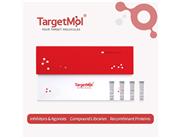| Name | Bardoxolone Methyl |
| Description | Bardoxolone Methyl (TP-155) is a synthetic triterpenoid that acts as an activator of the Nrf2 pathway and an inhibitor of the NF-κB pathway with potential anti-tumor and anti-inflammatory activities. |
| Cell Research | Leukemic cell lines are cultured at a density of 3.0 × 105 cells/mL, and AML mononuclear cells are cultured at 5 × 105 cells/mL in the presence or absence of indicated concentrations of CDDO-Me. Appropriate amounts of DMSO (final concentration less than 0.05%) are included as control. For cytotoxicity studies, 1 μM ara-C is added to the cultures. After 24 to 72 hours, viable cells are counted with the trypan blue dye exclusion method using a hematocytometer. (Only for Reference) |
| Kinase Assay | IKK assay : To determine the effect of CDDO-Me on TNF-induced IKK activation, IKK is analyzed. Briefly, the IKK complex from whole-cell extracts was precipitated with antibody against IKKα and IKKβ and then treated with protein A/G-Sepharose beads. After 2 hours, the beads are washed with lysis buffer and then resuspended in a kinase assay mixture containing 50 mmol/L HEPES (pH 7.4), 20 mmol/L MgCl2, 2 mmol/L DTT, 20 μCi [γ-32P]ATP, 10 μmol/L unlabeled ATP, and 2 μg of substrate glutathione S-transferase-IκBα (amino acids 1-54). After incubation at 30°C for 30 minutes, the reaction is terminated by boiling with SDS sample buffer for 5 minutes. Finally, the protein is resolved on 10% SDS-PAGE, the gel is dried, and the radioactive bands are visualized with a Storm820. To determine the total amounts of IKK-α and IKK-β in each sample, 50 μg of whole-cell proteins are resolved on 7.5% SDS-PAGE, electrotransferred to a nitrocellulose membrane, and then blotted with either anti-IKK-α or anti-IKK-β antibody. |
| In vitro | Bardoxolone Methyl exhibits potent inhibitory activities against production of nitric oxide induced by interferon-? in mouse macrophages with IC50 of 0.1 nM. [1] Bardoxolone Methyl decreases the viability of leukemic HL-60, KG-1, and NB4 cells with IC50 of 0.4, 0.4, and 0.27 μM, respectively. CDDO-Me induces pro-apoptotic Bax protein, inhibits the activation of ERK1/2, and it blocks Bcl-2 phosphorylation, which contributes to the induction of apoptosis. [2] Bardoxolone Methyl potently inhibits both constitutive and inducible NF-kappaB activated by TNF, interleukin (IL)-1beta, phorbol ester, okadaic acid, hydrogen peroxide, lipopolysaccharide, and cigarette smoke. [3] |
| In vivo | Bardoxolone Methyl (60 mg/kg) reduces the number, size, and severity of lung tumors in vivo. [4] Bardoxolone Methyl significantly reduces the in vivo inflammatory cytokine response following LPS challenge, induces HO-1 protein expression in the spleen, and protects mice against lethal-dose LPS. [5] |
| Storage | Powder: -20°C for 3 years | In solvent: -80°C for 1 year | Shipping with blue ice. |
| Solubility Information | H2O : < 1 mg/mL (insoluble or slightly soluble)
DMSO : 18.33 mg/mL (36.25 mM)
Ethanol : < 1 mg/mL (insoluble or slightly soluble)
|
| Keywords | TP155 | inhibit | Keap1-Nrf2 | Inhibitor | NSC713200 | RTA-402 | RTA402 | Apoptosis | Ferroptosis | Bardoxolone Methyl | TP 155 | Autophagy | NSC-713200 |
| Inhibitors Related | Stavudine | Sodium 4-phenylbutyrate | L-Ascorbic acid | Hydroxychloroquine | Guanidine hydrochloride | Tributyrin | Paeonol | Naringin |
| Related Compound Libraries | Bioactive Compound Library | Kinase Inhibitor Library | Anti-Cancer Clinical Compound Library | Drug Repurposing Compound Library | Inhibitor Library | FDA-Approved Kinase Inhibitor Library | Anti-Cancer Approved Drug Library | Anti-Aging Compound Library | Anti-Cancer Active Compound Library | Anti-Cancer Drug Library |

 United States
United States



